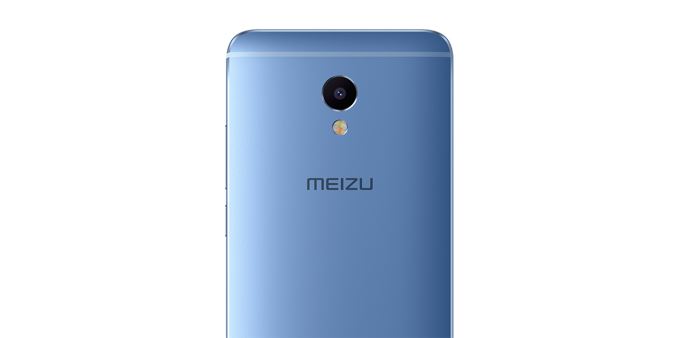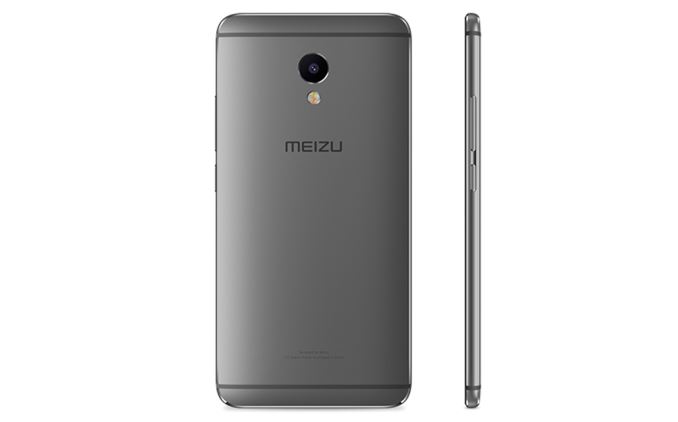Meizu M3E Launched: Helio P10, 5.5-inch Full HD, ¥1299
by Matt Humrick on August 10, 2016 2:45 PM EST- Posted in
- Smartphones
- Mobile
- MediaTek
- Meizu
- Helio P10

Today at a launch event in Beijing, Meizu announced the latest edition to its lower-cost M-series of smartphones. The M3E adheres to Meizu’s established design and construction methods, with an all-aluminum chassis topped with 2.5D edge-to-edge cover glass. The single-piece volume rocker and power button sit within a polished groove that matches the polished, chamfered edges around the sides as well as the recessed rear camera and flash modules. The M3E comes in five colors: silver, gray, blue, gold, and rose gold.
Like Meizu’s M3 note, the M3E comes with a fully laminated, 5.5-inch 1080p IPS LCD display with a peak brightness of 450 nits, according to Meizu. There’s a touch-based, capacitive fingerprint sensor below the screen that also works as a capacitive back button when tapped and a home button when pressed. Swiping up from the lower bezel opens the recent apps menu, which eliminates the need for additional capacitive or onscreen navigation buttons.
| Technical Specifications | ||
| Meizu M3E | Meizu M3 note | |
| SoC | MediaTek Helio P10 (MT6755M) 4x Cortex-A53 @ 1.8GHz 4x Cortex-A53 @ 1.0GHz Mali-T860MP2 |
MediaTek Helio P10 (MT6755M) 4x Cortex-A53 @ 1.8GHz 4x Cortex-A53 @ 1.0GHz Mali-T860MP2 @ 546MHz |
| RAM | 3GB LPDDR3 | 2GB / 3GB LPDDR3 |
| NAND | 32GB (eMMC 5.1) + microSD |
16GB / 32GB (eMMC 5.1) + microSD |
| Display | 5.5-inch 1920x1080 IPS LCD | 5.5-inch 1920x1080 IPS LCD |
| Dimensions | 153.6 x 75.8 x 7.9 mm 172 grams |
153.6 x 75.5 x 8.2 mm 163 grams |
| Modem | MediaTek (Integrated) 2G / 3G / 4G LTE (Category 6) FDD-LTE / TD-LTE / TD-SCDMA / WCDMA / CDMA / GSM |
MediaTek (Integrated) 2G / 3G / 4G LTE (Category 6) FDD-LTE / TD-LTE / TD-SCDMA / WCDMA / CDMA / GSM |
| SIM Size | 2x NanoSIM (dual standby) | 2x NanoSIM (dual standby) |
| Front Camera | 5MP, f/2.0 | 5MP, f/2.0 |
| Rear Camera | 13MP, 1/3.06" Sony IMX258 Exmor RS, 1.12µm pixels, f/2.2, PDAF, HDR, dual-tone LED flash | 13MP, 1/3.06" OmniVision OV13853, 1.12µm pixels, f/2.2, PDAF, HDR, dual-tone LED flash |
| Battery | 3100 mAh non-replaceable |
4100 mAh (15.79 Wh) non-replaceable |
| Connectivity | 802.11b/g/n/ac, BT 4.1 LE, GPS/GNSS, USB Type-C | 802.11b/g/n/ac, BT 4.0 LE, GPS/GNSS, microUSB 2.0 |
| Launch OS | Yun OS 5.1 with Meizu Flyme OS 5 | Android 5.1 with Meizu Flyme OS 5.1 |
| Launch Price (No Contract) |
¥1299 $196 USD |
¥799 / ¥999 $120 / $150 USD |
The table above shows significant overlap between the new M3E and the M3 note. They both use the same MediaTek Helio P10 SoC with four ARM Cortex-A53 CPUs at up to 1.8GHz and another four at up to 1.0GHz in a big.LITTLE arrangement. There’s also an ARM Mali-T860MP2 GPU, which features two ALUs per core instead of three ALUs per core like the high-end Mali-T880.
In our M3 note review, the Helio P10 delivered adequate performance for light workloads, but could not match the speed and user experience of Qualcomm’s Snapdragon 650 SoC in the similarly priced Xiaomi Redmi Note 3. The Helio P10’s low-power GPU is also unsuitable for serious gaming, but is sufficient for playing casual titles.
The M3E comes with 3GB of LPDDR3-1866 RAM and 32GB of eMMC 5.1 NAND, also like the M3 note. Both phones also support microSD cards for storage expansion and 802.11ac Wi-Fi, which is nice to see at this price point, but neither phone includes NFC. The M3E at least ditches microUSB in favor of the newer Type-C port.
MediaTek’s Category 6 LTE modem comes integrated with the Helio P10 SoC, offering up to 300 Mb/s down and 50 Mb/s up with 2x20 MHz carrier aggregation and 64-QAM on the downlink. Both the M3E and M3 note accept dual NanoSIM cards and support Dual SIM Dual Standby (DSDS) operation. Meizu says the M3E supports 18 frequency bands, which is the same number as the mainland China version of the M3 note. Based on the hardware similarities, it’s likely the M3E supports the same frequency bands as the M3 note, which means no support for North American LTE frequencies.
The M3E comes with a 5MP front-facing camera and 13MP rear camera with phase detect autofocus (PDAF); however, the M3E is using a Sony IMX258 image sensor for the rear camera. The M3 note’s camera performed poorly in our testing, so hopefully this change improves image quality.
Overall, the M3E appears to be a minor revision of the M3 note. It’s updated design, USB Type-C port, and new rear camera are offset by a significantly smaller battery. It’s also disappointing to see Meizu stick with the Helio P10 SoC. The Redmi Note 3’s Snapdragon 650, which includes two Cortex-A72 CPUs and an Adreno 510 GPU, provides a substantially better user experience at a similar price.












20 Comments
View All Comments
jjj - Wednesday, August 10, 2016 - link
How sure are you that it has wifi ac? They don't list it on their site but they did the same with the Note 3.The model number for the SoC for both is MT6755m , that's 1.8GHz, the vanilla MT6755 is at 1.95GHz.
CloudWiz - Wednesday, August 10, 2016 - link
Still no E8890/SD820 architecture/power deep dive? Andrei said it was in the works many months ago, it's been over half a year since the first Kryo architectural article and 5 months since the release of the GS7's. Is there any legitimate reason for this besides "busy schedule, lack of writers, and time zone differences"?Psyside - Wednesday, August 10, 2016 - link
Agree, i could care less for this phone when you got RN3P for the same price, its literally 2x better.Psyside - Wednesday, August 10, 2016 - link
I can't wait for the deep dive article, so much time passed very disappointing.mr_tawan - Wednesday, August 10, 2016 - link
At first I thought "What... $1299 ?? that's crazy" and then I noticed that it's not $.... Second I thought well it's .... 1299 yen, but that's too low ....Turns out to be Chinese Yuan.
kyuu - Thursday, August 11, 2016 - link
Yeah it's a bit confusing that Chinese Yuan and Japanese Yen use the same symbol.mr_tawan - Thursday, August 11, 2016 - link
It's probably better to use currency code instead of dollar signs.djayjp - Thursday, August 11, 2016 - link
Why would anyone buy this over the Redmi Note 3 Qualcomm with two A72 cores for the same price...?serendip - Thursday, August 11, 2016 - link
The Redmi Note 3 with the SD650 is 899 yuan for 2GB/16GB or 1099 for 3GB/32GB. That's a heck of a bargain for a phone that can go against flagships costing 3x more. The modding scene is also a lot more active with Qualcomm-based devices because Mediatek are stingy when it comes to kernel sources.fanofanand - Thursday, August 11, 2016 - link
How does it go against the flagships? DDR3, EMMC, A53, 1080 resolution, and a GPU that can't handle basic gaming. How exactly does this challenge flagships?